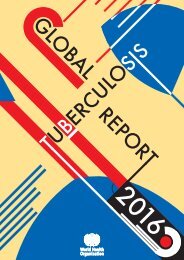patients
DNDi_AR_2015
DNDi_AR_2015
Create successful ePaper yourself
Turn your PDF publications into a flip-book with our unique Google optimized e-Paper software.
R&D MODEL & PORTFOLIO<br />
LEISHMANIASIS<br />
TRANSLATION<br />
CpG-D35 (CL)<br />
PROJECT START: June 2014<br />
OVERALL OBJECTIVE: Characterize and produce GMP-grade D35 to<br />
evaluate its protective cellular immunity and its effectiveness to<br />
treat PKDL and CL in chemotherapy combinations<br />
2015 OBJECTIVE: Advance the pre-clinical development<br />
of CpG-D35<br />
CpG-D35 is being developed as a combination therapy for the<br />
treatment of complicated cutaneous leishmaniasis and post<br />
kala-azar dermal leishmaniasis (PKDL). Leishmania parasites<br />
are able to persist in host cells by evading or exploiting<br />
immune mechanisms. Modulating the immune response<br />
with CpG oligonucleotides may improve the effectiveness of<br />
chemotherapies. The project has four phases: production and<br />
characterization of GMP-grade CpG-D35, pre-clinical studies<br />
in two species to assess potential toxicities, Phase I clinical<br />
trials in healthy volunteers, and proof-of-concept clinical<br />
trials in <strong>patients</strong> for CpG-D35 and the combination of CpG-<br />
D35 with chemotherapy. In 2015 IND-enabling pre-clinical<br />
safety prerequisites and service providers for entry into Phase I<br />
proof-of-concept clinical trials were identified.<br />
MAIN PARTNERS: US FDA, USA; National Institutes of Health (NIH),<br />
USA; Ohio State University, USA; Nagasaki University, Japan;<br />
University of Osaka, Japan; GeneDesign Inc., Japan<br />
New CL combination therapies<br />
PROJECT START: June 2015<br />
OVERALL OBJECTIVE: Develop an improved treatment for CL based<br />
on existing treatments used in combination<br />
2015 OBJECTIVE: Obtain approval of the proposed study<br />
The efficacy of currently available and approved CL treatment<br />
approaches (antimonials, miltefosine, and thermotherapy) is<br />
approximately 70-75% worldwide. The safety profiles of these<br />
approaches when administrated alone is very well established.<br />
Using a combination of therapies may both improve this<br />
efficacy rate and reduce the length of treatment and rate of<br />
adverse events. A combination of one single application of<br />
thermotherapy at 50°C for 30 seconds with a 3 week course<br />
of oral miltefosine will be tested in order to gain information<br />
about safety and efficacy, with no anticipated safety problems<br />
and in a short period of time. The study protocol was finalized<br />
and submitted for review by local ethics committees in 2015;<br />
approval was received from Peru and Colombia in December<br />
2015. It will be submitted to regulatory authorities in 2016 and<br />
patient enrolment is expected to begin the same year.<br />
MAIN PARTNERS: Programa de Estudio y Control de Enfermedades<br />
Tropicales, Universidad de Antioquia, Medellin, Colombia; Instituto<br />
de Medicina Tropical Alexander von Humboldt, Universidad Peruana<br />
Cayetano Heredia, Lima, Peru<br />
Anfoleish (CL)<br />
PROJECT START: September 2011<br />
OVERALL OBJECTIVE: Develop at least one modality<br />
of treatment for CL<br />
2015 OBJECTIVE: Continue enrolment in the Phase Ib/II exploratory<br />
study and have an indication of the safety, PK, and efficacy<br />
80 <strong>patients</strong><br />
recruited at 1 site<br />
The rationale for development of a<br />
topical formulation of amphotericin B<br />
was to provide a treatment to be applied<br />
locally at the CL lesion, showing high anti-parasitic effect, but<br />
without the systemic toxicity associated with amphotericin B.<br />
A Phase Ib/II open-label, randomized, non-comparative,<br />
two-arm exploratory study is being conducted in Colombia.<br />
Initially planned to include only <strong>patients</strong> with CL caused by<br />
L. braziliensis, recruitment was widened to include <strong>patients</strong><br />
with CL caused by L. panamensis. Enrolment of all 80 <strong>patients</strong><br />
was completed in November 2015, and preliminary data on<br />
cure will be available in 2016.<br />
If Anfoleish is shown to be efficacious against L. braziliensis<br />
and L. panamesis, a multi-country Phase III study will be<br />
planned in Latin America.<br />
MAIN PARTNERS: Humax Pharmaceutical, Medellin, Colombia;<br />
Programa de Estudio y Control de Enfermedades Tropicales,<br />
Universidad de Antioquia, Medellin, Colombia<br />
32 › DNDi Annual Report 2015



